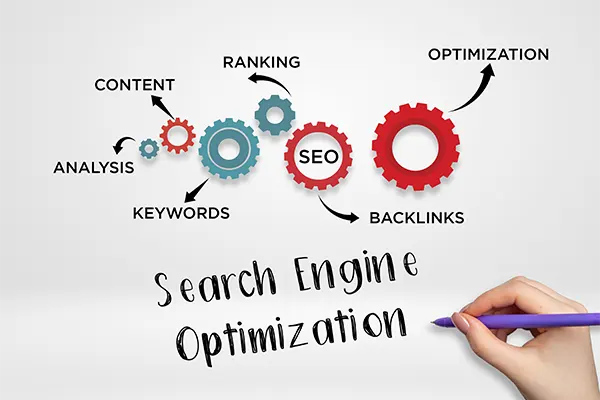
In today’s digital landscape, having a well-designed website is no longer a luxury; it’s a necessity. However, even the most visually appealing website is of little value if it doesn’t attract visitors. This is where the integration of web development and SEO (Search Engine Optimization) comes into play. When these two essential components of digital marketing work in harmony, they create a powerful synergy that can significantly enhance a website’s performance and visibility. In this article, we will explore the importance of integrating web development and SEO, and how these teams can collaborate to build search-engine-friendly websites that not only look great but also rank high on search engines.
The Symbiotic Relationship Between Web Development and SEO

- Understanding Web Development
Web development encompasses the technical aspects of building and maintaining a website. It involves coding, programming, and creating the functionality that allows a website to operate smoothly. Web developers focus on the backend and frontend development, ensuring that the website is fast, secure, and user-friendly.
- Understanding SEO
SEO, on the other hand, is the practice of optimizing a website to improve its ranking on search engine results pages (SERPs). SEO involves a variety of strategies and techniques, including keyword research, content optimization, link building, and technical SEO. The goal of SEO is to increase organic traffic to a website by making it more visible and attractive to search engines.
- The Interconnection
Web development and SEO are inherently connected. A well-developed website provides the foundation upon which effective SEO strategies can be built. Conversely, SEO considerations should be integrated into the web development process from the beginning to ensure that the website is optimized for search engines right from the start.

The Benefits of Integrating Web Development and SEO

- Improved User Experience (UX)
A website that is both well-developed and optimized for search engines offers a superior user experience. This includes fast loading times, easy navigation, mobile-friendliness, and relevant, high-quality content. A positive UX leads to higher engagement, lower bounce rates, and increased conversions.
- Enhanced Website Performance
Integrating SEO into web development ensures that the website is built with performance in mind. This includes optimizing code, compressing images, and using efficient hosting solutions. A high-performing website is more likely to rank well on search engines and provide a better experience for users.
Visit: tips for creative web design
- Higher Search Engine Rankings
Websites that are developed with SEO best practices in mind are more likely to rank higher on search engines. This includes having clean and crawlable code, using proper heading tags, optimizing meta descriptions, and ensuring that the site is mobile-friendly. Higher rankings lead to increased organic traffic and visibility.
- Cost-Effective Marketing
By integrating web development and SEO, businesses can save time and money in the long run. Instead of retrofitting SEO strategies onto an existing website, the site is built with SEO in mind from the ground up. This reduces the need for extensive rework and ensures that the website is optimized from day one. Our web development company in India brings your vision to life with a website that gives you a competitive edge in the digital landscape.
How Web Development and SEO Teams Can Collaborate?

Communication and Collaboration
The first step in integrating web development and SEO is fostering effective communication and collaboration between the two teams. This involves:
- Regular Meetings: Hold regular meetings between web developers and SEO specialists to discuss project goals, progress, and challenges.
- Shared Tools and Platforms: Use shared tools and platforms to facilitate collaboration and ensure that both teams are on the same page. This could include project management software, code repositories, and analytics tools.
- Clear Goals and Objectives: Establish clear goals and objectives for the project, ensuring that both teams understand the importance of integrating SEO into the web development process.

SEO Considerations in Web Development
- Website Architecture
The structure of a website plays a crucial role in its SEO performance. A well-organized website with a clear hierarchy and intuitive navigation makes it easier for search engines to crawl and index the site. Web developers should work with SEO specialists to create a logical and user-friendly site structure.
2. URL Structure
URLs should be clean, descriptive, and easy to read. Avoid using long, complicated URLs with unnecessary parameters. Instead, use keywords in the URL to describe the content of the page. For example, instead of using a URL like www.example.com/page?id=123, use www.example.com/seo-tips.
3. Mobile-Friendliness
With the increasing use of mobile devices to access the internet, having a mobile-friendly website is essential. Web developers should use responsive design techniques to ensure that the website looks and functions well on all devices. Google also prioritizes mobile-friendly websites in its search rankings.

4. Page Speed
Page speed is a critical factor in both user experience and SEO. Slow-loading websites can lead to high bounce rates and lower search engine rankings. Web developers should optimize code, compress images, and leverage browser caching to improve page speed.
5. Secure Website (HTTPS)
Security is a top priority for both users and search engines. Websites that use HTTPS encryption are considered more trustworthy and are given a ranking boost by Google. Web developers should ensure that the website is secure by implementing SSL certificates.
Visit: best security practices for website development
On-Page SEO Optimization
- Title Tags and Meta Descriptions
Title tags and meta descriptions are essential elements of on-page SEO. They provide a brief summary of the content on a page and appear in search engine results. Web developers should work with SEO specialists to ensure that these elements are optimized with relevant keywords and accurately reflect the content of the page.
2. Heading Tags (H1, H2, H3, etc.)
Proper use of heading tags helps search engines understand the structure and content of a page. The H1 tag should be used for the main heading, while H2 and H3 tags can be used for subheadings. Web developers should use heading tags appropriately and ensure that they are optimized with relevant keywords.
3. Alt Text for Images
Alt text provides a description of an image and helps search engines understand the content of the image. It is also important for accessibility, as it allows screen readers to describe the image to visually impaired users. Web developers should ensure that all images have descriptive alt text.
4. Internal Linking
Internal linking helps search engines understand the relationship between different pages on a website. It also helps users navigate the site and find related content. Web developers should work with SEO specialists to create a logical internal linking structure that enhances both user experience and SEO.
5. Content Optimization
High-quality, relevant content is a cornerstone of effective SEO. Web developers should ensure that the website is designed to showcase content in an engaging and user-friendly manner. SEO specialists should optimize the content with relevant keywords, headings, and internal links.

Technical SEO
- XML Sitemaps
An XML sitemap is a file that lists all the pages on a website, helping search engines crawl and index the site more efficiently. Web developers should create and submit an XML sitemap to search engines like Google and Bing.
2. Robots.txt
The robots.txt file provides instructions to search engine crawlers about which pages to crawl and index. Web developers should use the robots.txt file to control access to certain parts of the website and prevent search engines from indexing duplicate or irrelevant content.
3. Canonical Tags
Canonical tags are used to indicate the preferred version of a web page when there are multiple versions with similar content. This helps prevent duplicate content issues and ensures that search engines index the correct version of the page. Web developers should implement canonical tags where necessary.
4. Structured Data (Schema Markup)
Structured data, or schema markup, provides additional context to search engines about the content of a page. This can enhance search engine results with rich snippets, such as star ratings, reviews, and event information. Web developers should work with SEO specialists to implement structured data where applicable. Our the best SEO company in India delivers excellence in SEO, ensuring your website stands out and attracts the right audience with precision.
5. 404 Error Pages
A 404 error page is displayed when a user tries to access a non-existent page on a website. While these errors are inevitable, web developers should create custom 404 error pages that provide helpful information and direct users to other parts of the website.
Case Study: Successful Integration of Web Development and SEO

To illustrate the benefits of integrating web development and SEO, let’s look at a case study of a company that successfully implemented this approach.
- The Challenge
A mid-sized e-commerce company was struggling with low organic traffic and high bounce rates on its website. Despite having a visually appealing website, it was not ranking well on search engines, and users were leaving the site quickly.
- The Solution
The company decided to integrate its web development and SEO efforts to address these issues. Here’s how they did it:
- Collaborative Planning
The web development and SEO teams held regular meetings to discuss the project’s goals and strategies. They used shared project management tools to track progress and ensure alignment.
- Site Structure and Navigation
The teams worked together to redesign the website’s structure and navigation. They created a logical hierarchy with clear categories and subcategories, making it easier for users and search engines to navigate the site.
- Mobile Optimization
The web development team implemented responsive design techniques to ensure that the website was mobile-friendly. They also optimized page speed by compressing images and leveraging browser caching.
- On-Page SEO
The SEO team optimized title tags, meta descriptions, and heading tags with relevant keywords. They also added alt text to all images and created an internal linking structure that guided users to related content.
- Technical SEO
The web development team created and submitted an XML sitemap and configured the robots.txt file. They also implemented canonical tags and structured data to enhance search engine visibility.
The Results
Within six months, the company saw significant improvements in its website’s performance:
- Increased Organic Traffic: Organic traffic increased by 50%, leading to more potential customers visiting the site.
- Higher Search Engine Rankings: The website’s search engine rankings improved for key target keywords, resulting in higher visibility.
- Lower Bounce Rates: Bounce rates decreased by 30%, indicating that users were finding the content more relevant and engaging.
- Improved Conversion Rates: The conversion rate increased by 20%, leading to higher sales and revenue.
Visit: user experience design principles
Conclusion
Integrating web development and SEO is crucial for creating search-engine-friendly websites that deliver optimal results. By fostering collaboration between web development and SEO teams, businesses can build websites that not only look great but also perform well on search engines. This integration leads to improved user experience, higher search engine rankings, and cost-effective marketing. As we’ve seen from the case study, the benefits of this approach are substantial, resulting in increased organic traffic, better engagement, and higher conversion rates.
In today’s competitive digital landscape, the synergy between web development and SEO is more important than ever. By prioritizing this integration, businesses can create a strong online presence and achieve long-term success. Remember, a well-developed website is the foundation of effective SEO, and together, they form a powerful combination that drives optimal results.
Why Adzmode?
- More than 800 happy clients across the globe
- Managing Digital Marketing Since 2011
- Indomitable Digital Marketing Strategies
- Founded by team of IIT Delhi Certified Digital Marketers
- 100% Transparency in Operations and Ad Budgets.
Share Your Project Requirements With Us






